Fiber-Reinforced Polyester Composites with Photoluminescence Sensing Capabilities for UV Degradation Monitoring
Abstract
:1. Introduction
2. Materials and Methods
2.1. Materials
2.2. Synthesis of YAG:Ce,Ga Particles
2.3. Preparation of the Laminated Composites
2.4. Degradation Tests and Characterization Techniques
3. Results and Discussion
3.1. YAG:Ce,Ga Particles Characterization
3.2. Morphological Characterization
3.3. Mechanical Characterization
3.4. Optical Characteristics
4. Conclusions
Author Contributions
Funding
Institutional Review Board Statement
Informed Consent Statement
Data Availability Statement
Acknowledgments
Conflicts of Interest
References
- Rajak, D.K.; Pagar, D.D.; Menezes, P.L.; Linul, E. Fiber-Reinforced Polymer Composites: Manufacturing, Properties, and Applications. Polymers 2019, 11, 1667. [Google Scholar] [CrossRef] [PubMed]
- Chang, J.; Newhouse, N. Fiber-Reinforced Polymer Matrix Composites: Pressure Vessels for Aerospace Applications. Encycl. Aerosp. Eng. 2010. [Google Scholar] [CrossRef]
- Ali, H.T.; Akrami, R.; Fotouhi, S.; Bodaghi, M.; Saeedifar, M.; Yusuf, M.; Fotouhi, M. Fiber Reinforced Polymer Composites in Bridge Industry. Structures 2021, 30, 774–785. [Google Scholar] [CrossRef]
- Spasova, D.; Argirov, Y.; Mechkarova, T.; Atanasov, N. Investigation of the Suitability of Fiber Reinforced Polymer Matrix Composites for Facilities Operating in Marine Environment. IOP Conf. Ser. Mater. Sci. Eng. 2021, 1037, 012029. [Google Scholar] [CrossRef]
- Bagherpour, S. Fibre Reinforced Polyester Composites. In Polyester; Saleh, H.M., Ed.; IntechOpen: London, UK, 2012. [Google Scholar]
- Patel, D.K.; Waas, A.M. Multiscale Modeling of Tensile Fracture in Fiber Reinforced Composites. Compos. Part C Open Access 2020, 2, 100016. [Google Scholar] [CrossRef]
- Gao, J.; Kedir, N.; Hernandez, J.A.; Gao, J.; Horn, T.; Kim, G.; Fezzaa, K.; Tallman, T.N.; Palmese, G.; Sterkenburg, R.; et al. Dynamic Fracture of Glass Fiber-Reinforced Ductile Polymer Matrix Composites and Loading Rate Effect. Compos. Part B Eng. 2022, 235, 109754. [Google Scholar] [CrossRef]
- Zaghloul, M.Y.; Zaghloul, M.M.Y.; Zaghloul, M.M.Y. Influence of Stress Level and Fibre Volume Fraction on Fatigue Performance of Glass Fibre-Reinforced Polyester Composites. Polymers 2022, 14, 2662. [Google Scholar] [CrossRef]
- Zaghloul, M.Y.M.; Zaghloul, M.M.Y.; Zaghloul, M.M.Y. Developments in Polyester Composite Materials—An in-Depth Review on Natural Fibres and Nano Fillers. Compos. Struct. 2021, 278, 114698. [Google Scholar] [CrossRef]
- Meng, J.; Wang, Y. A Review on Artificial Aging Behaviors of Fiber Reinforced Polymer-Matrix Composites. MATEC Web Conf. 2016, 67, 06041. [Google Scholar] [CrossRef]
- Syamsir, A.; Arifin, Z.; Ishak, M.; Yusof, Z.M. Durability Control of UV Radiation in Glass Fiber Reinforced Polymer (GFRP)-A Review. AIP Conf. Proc. 2018, 2031, 20026. [Google Scholar] [CrossRef]
- Pei, X.; Han, W.; Ding, G.; Wang, M.; Tang, Y. Temperature Effects on Structural Integrity of Fiber-Reinforced Polymer Matrix Composites: A Review. J. Appl. Polym. Sci. 2019, 136, 48206. [Google Scholar] [CrossRef]
- Rippert, L.; Wevers, M.; Van Huffel, S. Optical and Acoustic Damage Detection in Laminated CFRP Composite Materials. Compos. Sci. Technol. 2000, 60, 2713–2724. [Google Scholar] [CrossRef]
- Groo, L.A.; Nasser, J.; Zhang, L.; Steinke, K.; Inman, D.; Sodano, H. Laser Induced Graphene in Fiberglass-Reinforced Composites for Strain and Damage Sensing. Compos. Sci. Technol. 2020, 199, 108367. [Google Scholar] [CrossRef]
- Groo, L.A.; Nasser, J.; Inman, D.J.; Sodano, H.A. Transfer Printed Laser Induced Graphene Strain Gauges for Embedded Sensing in Fiberglass Composites. Compos. Part B Eng. 2021, 219, 108932. [Google Scholar] [CrossRef]
- Zhang, M.; Bareille, O.; Salvia, M. Cure and Damage Monitoring of Flax Fiber-Reinforced Epoxy Composite Repairs for Civil Engineering Structures Using Embedded Piezo Micro-Patches. Constr. Build. Mater. 2019, 225, 196–203. [Google Scholar] [CrossRef]
- Cohades, A.; Branfoot, C.; Rae, S.; Bond, I.; Michaud, V.; Cohades, A.; Michaud, V.; Branfoot, C.; Rae, S.I.; Bond, I. Progress in Self-Healing Fiber-Reinforced Polymer Composites. Adv. Mater. Interfaces 2018, 5, 1800177. [Google Scholar] [CrossRef]
- Woldesenbet, E. Self-Healing in Single and Multiple Fiber(s) Reinforced Polymer Composites. EPJ Web. Conf. 2010, 6, 05002. [Google Scholar] [CrossRef]
- Shin, Y.-H.; Gutierrez-Wing, M.T.; Choi, J.-W. Review—Recent Progress in Portable Fluorescence Sensors. J. Electrochem. Soc. 2021, 168, 017502. [Google Scholar] [CrossRef]
- Roche, S.; Ibarz, G.; Crespo, C.; Chiminelli, A.; Araujo, A.; Santos, R.; Zhang, Z.; Li, X.; Dong, H. Self-Sensing Polymeric Materials Based on Fluorescent Microcapsules for the Detection of Microcracks. J. Mater. Res. Technol. 2022, 16, 505–515. [Google Scholar] [CrossRef]
- Augustyniak, A.; Tsavalas, J.; Ming, W. Early Detection of Steel Corrosion via “Turn-on” Fluorescence in Smart Epoxy Coatings. ACS Appl. Mater. Interfaces 2009, 1, 2618–2623. [Google Scholar] [CrossRef]
- Su, F.; Du, X.; Shen, T.; Qin, A.; Li, W. Aggregation-Induced Emission Luminogens Sensors: Sensitive Fluorescence ‘Turn-On’ Response for PH and Visually Chemosensoring on Early Detection of Metal Corrosion. Prog. Org. Coat. 2021, 153, 106122. [Google Scholar] [CrossRef]
- Makyła, K.; Müller, C.; Lörcher, S.; Winkler, T.; Nussbaumer, M.G.; Eder, M.; Bruns, N. Fluorescent Protein Senses and Reports Mechanical Damage in Glass-Fiber-Reinforced Polymer Composites. Adv. Mater. 2013, 25, 2701–2706. [Google Scholar] [CrossRef] [PubMed]
- Tubio, C.R.; Seoane-Rivero, R.; Garcia, A.; Gallardo, A.; Salaverria, L.D.; Amondarian, A.L.A.; Zubieta, K.G.; Lanceros-Mendez, S. Self-Sensing Fluorescence Polymer Composites for Chemical Degradation Protection and Monitoring. Prog. Org. Coat. 2022, 168, 106879. [Google Scholar] [CrossRef]
- Ronda, C.R. Luminescence: From Theory to Applications; Wiley-VCH, Verlag GmbH & Co: Weinheim, Germany, 2008. [Google Scholar]
- Madani, A.; Ma, L.; Miao, S.; Jorgensen, M.R.; Schmidt, O.G. Luminescent Nanoparticles Embedded in TiO2 Microtube Cavities for the Activation of Whispering-Gallery-Modes Extending from the Visible to the near Infrared. Nanoscale 2016, 8, 9498–9503. [Google Scholar] [CrossRef] [PubMed]
- Berends, A.C.; Van De Haar, M.A.; Krames, M.R. YAG:Ce3+ Phosphor: From Micron-Sized Workhorse for General Lighting to a Bright Future on the Nanoscale. Chem. Rev. 2020, 120, 13461–13479. [Google Scholar] [CrossRef] [PubMed]
- He, X.; Liu, X.; You, C.; Zhang, Y.; Li, R.; Yu, R. Clarifying the Preferential Occupation of Ga3+ Ions in YAG:Ce,Ga Nanocrystals with Various Ga3+-Doping Concentrations by Nuclear Magnetic Resonance Spectroscopy. J. Mater. Chem. C 2016, 4, 10691–10700. [Google Scholar] [CrossRef]
- Pan, Y.X.; Wang, W.; Liu, G.K.; Skanthakumar, S.; Rosenberg, R.A.; Guo, X.Z.; Li, K.K. Correlation between Structure Variation and Luminescence Red Shift in YAG:Ce. J. Alloys Compd. 2009, 488, 638–642. [Google Scholar] [CrossRef]
- Garskaite, E.; Lindgren, M.; Einarsrud, M.A.; Grande, T. Luminescent Properties of Rare Earth (Er, Yb) Doped Yttrium Aluminium Garnet Thin Films and Bulk Samples Synthesised by an Aqueous Sol–gel Technique. J. Eur. Ceram. Soc. 2010, 30, 1707–1715. [Google Scholar] [CrossRef]
- Woo, R.S.C.; Chen, Y.; Zhu, H.; Li, J.; Kim, J.K.; Leung, C.K.Y. Environmental Degradation of Epoxy–organoclay Nanocomposites Due to UV Exposure. Part I: Photo-Degradation. Compos. Sci. Technol. 2007, 67, 3448–3456. [Google Scholar] [CrossRef]
- Cordeiro, C.C.; Vieira, J.D.; Có, C.M. Tensile Properties and Color and Mass Variations of GFPR Composites under Alkaline and Ultraviolet Exposures. Matéria 2016, 21, 1–10. [Google Scholar] [CrossRef] [Green Version]
- Kumar, B.G.; Singh, R.P.; Nakamura, T. Degradation of Carbon Fiber-Reinforced Epoxy Composites by Ultraviolet Radiation and Condensation. J. Compos. Mater. 2002, 36, 2713–2733. [Google Scholar] [CrossRef]
- Verma, R.; Rathod, M.J.; Goyal, R.K. A Review on the Effect of Processing Techniques and Functionalization of Filler on Mechanical Properties of Polymer Nanocomposites. IOP Conf. Ser. Mater. Sci. Eng. 2020, 798, 012031. [Google Scholar] [CrossRef]
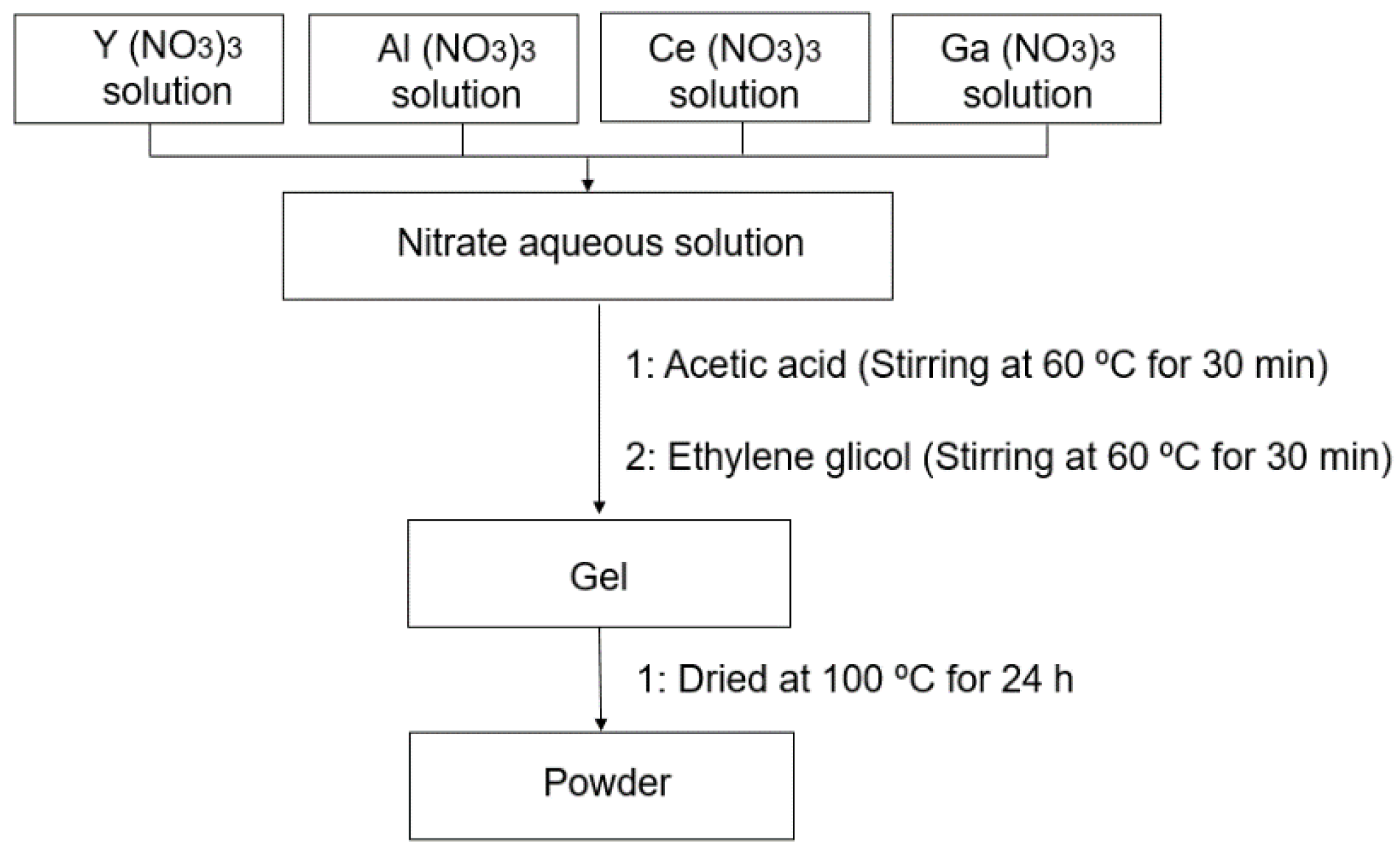
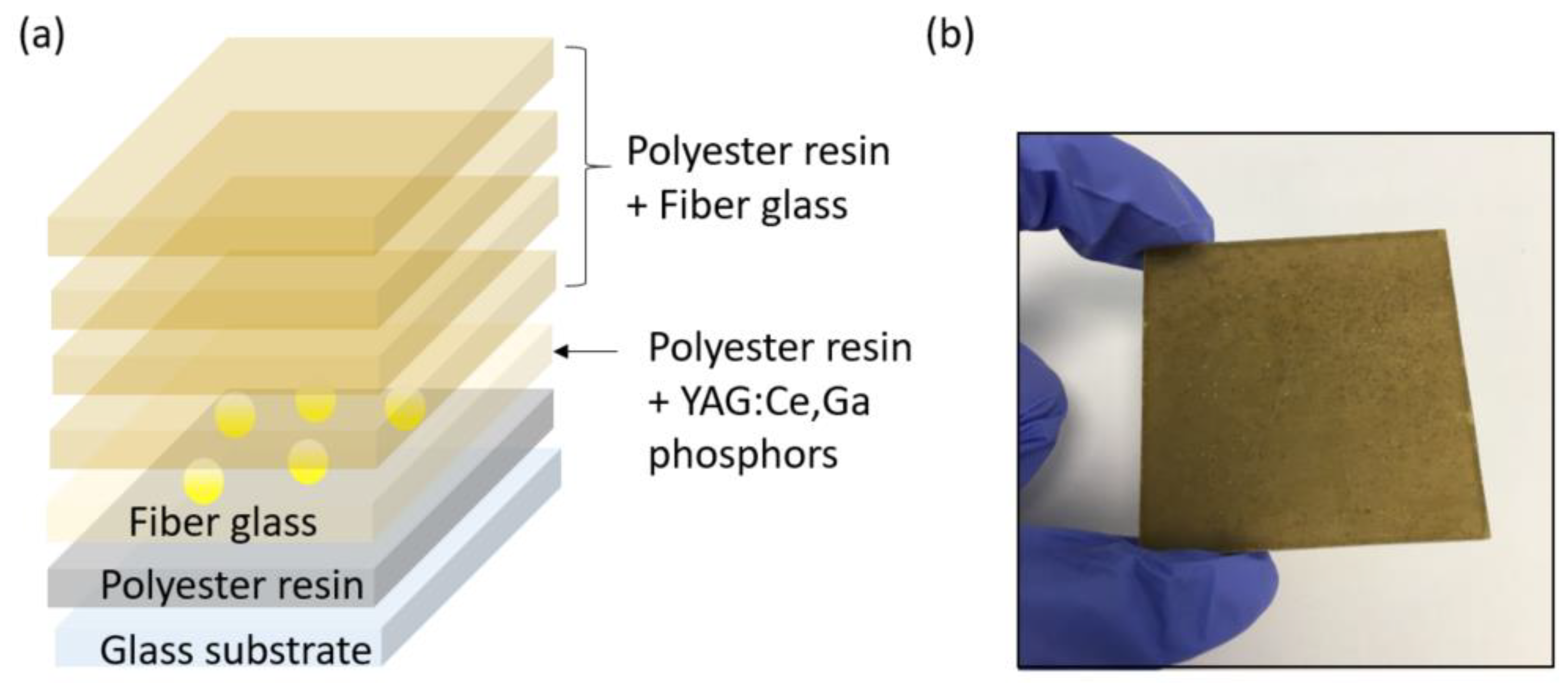
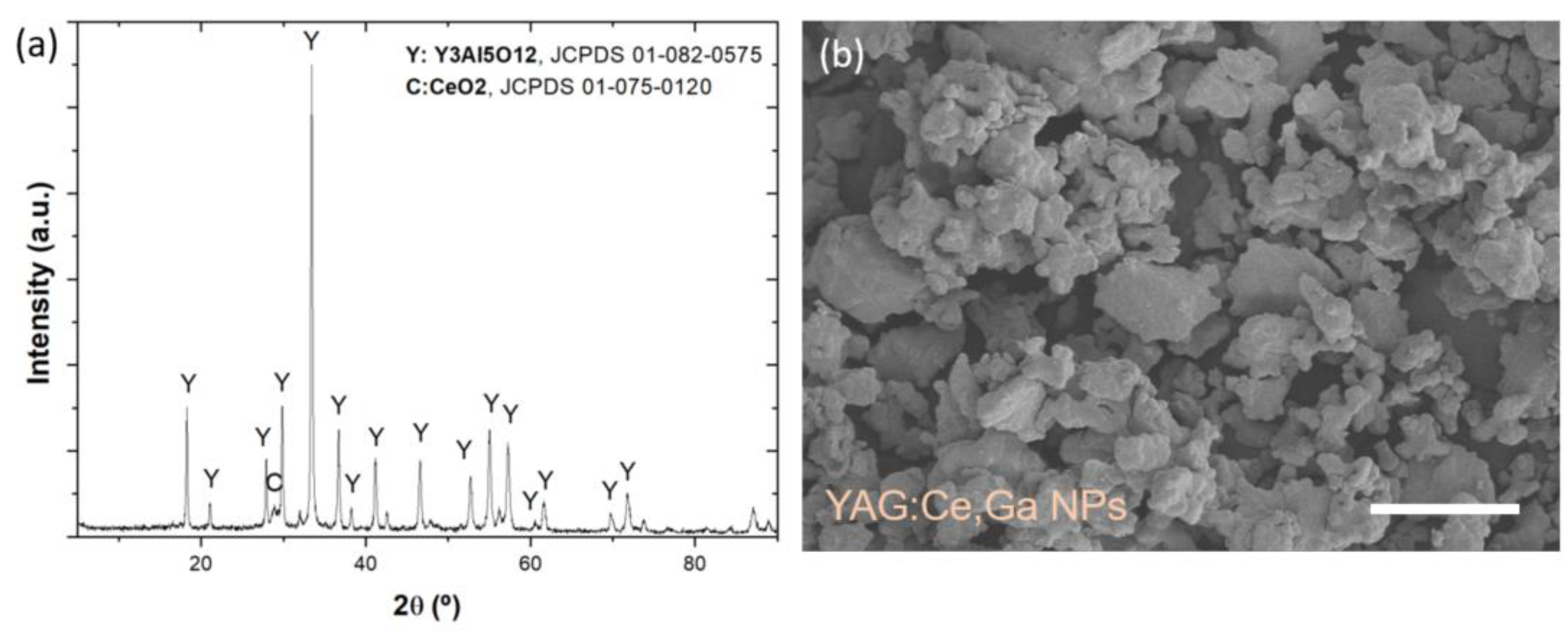


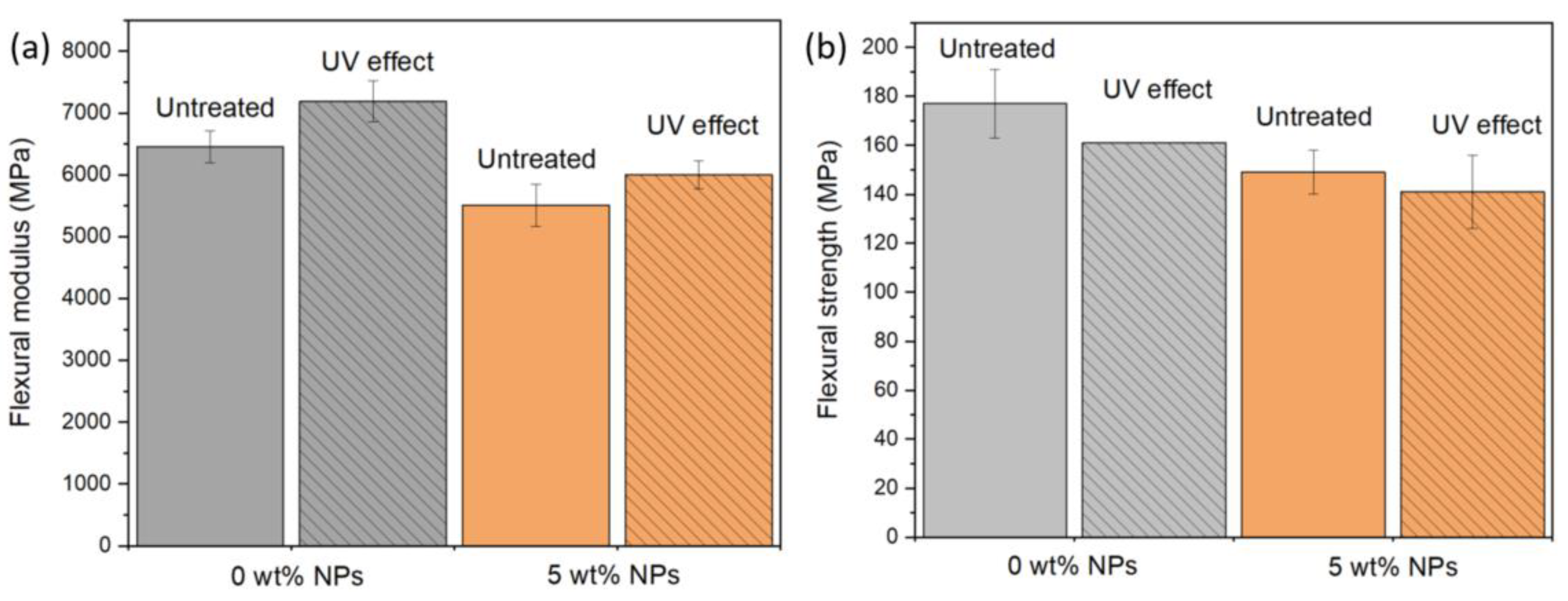


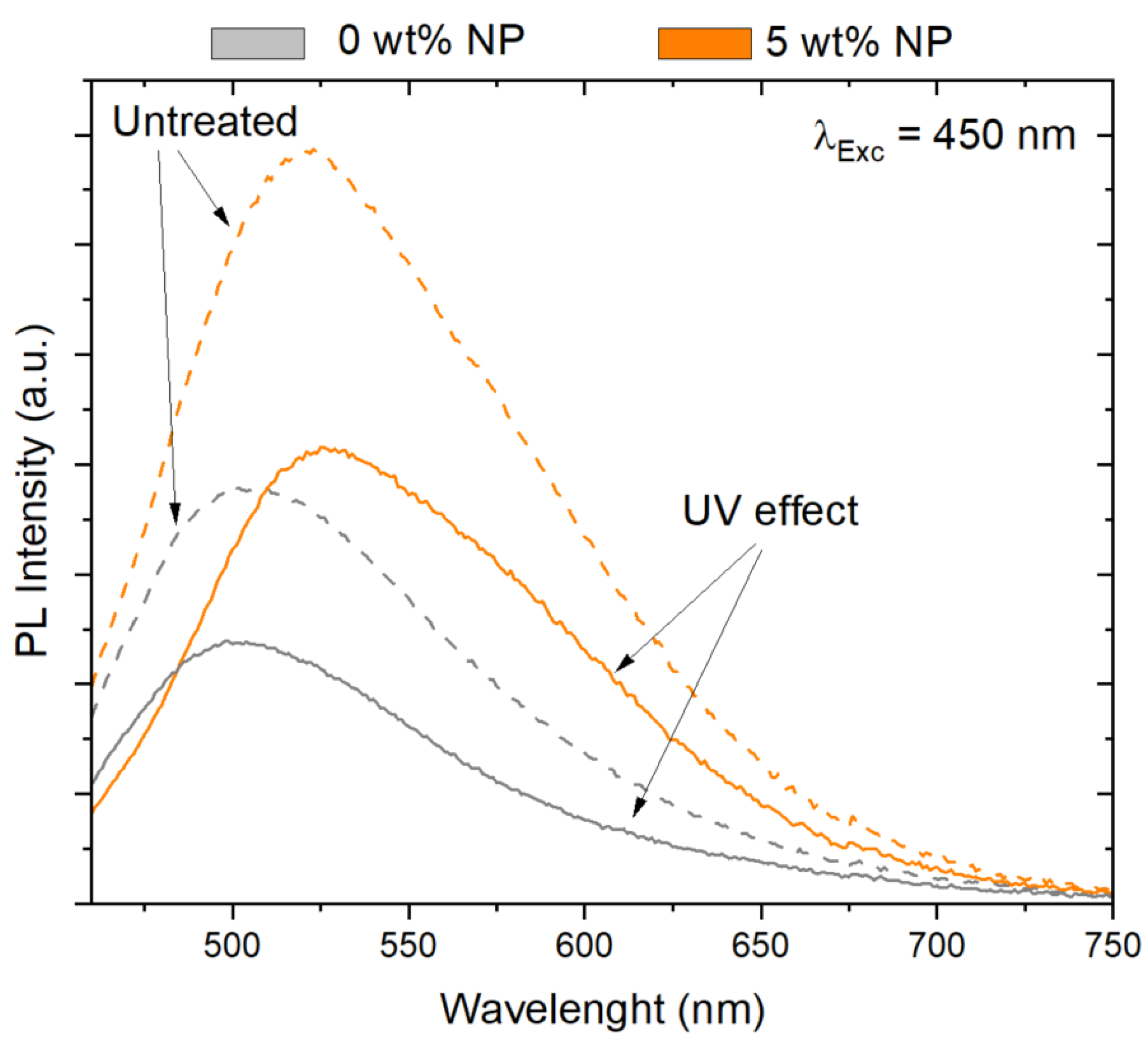

| Polyester Resin | |
| Mass density | 1.11 g/cm3 |
| Elongation at break | 3900 MPa |
| Tensile strength | 50 MPa |
| Viscosity at 25 °C | 670–830 mPa·s |
| Barcol hardness | 42 |
| Fiber glass MAT | |
| Surface weight | 300 g/cm2 |
| Breaking force | Min. 50 N |
| Fiber glass MAT surface veil | |
| Area weight | 30 g/m2 |
| Tensile strength | ≥40 N/50 mm |
| Element Content (wt.%) | |||||||
|---|---|---|---|---|---|---|---|
| Samples | C | O | Si | Al | Ce | Au | |
| 0 wt.% | Untreated | 81.44 | 15.54 | 0.33 | - | - | 2.70 |
| UV | 55.2 | 39.21 | 1.34 | 0.34 | - | 3.81 | |
| 1 wt.% | Untreated | 79.29 | 18.14 | - | - | - | 2.54 |
| UV | 52.03 | 42.56 | 1.97 | 0.60 | - | 2.83 | |
| 3 wt.% | Untreated | 76.66 | 18.30 | 0.43 | - | - | 4.61 |
| UV | 55.66 | 39.77 | 3.69 | 0.88 | - | 4.46 | |
| 5 wt.% | Untreated | 81.15 | 13.78 | 0.24 | - | - | 4.83 |
| UV | 56.9 | 21.43 | 8.66 | 0.71 | 2.77 | 9.52 | |
| Surface Roughness Sa (nm) | ||
|---|---|---|
| Sample | Untreated | UV Exposure |
| 0 wt.% | 12.6 | 78.3 |
| 1 wt.% | 10.99 | 1896.6 |
| 3 wt.% | 12.4 | 2901 |
| 5 wt.% | 8.7 | 3200 |
| Barcol Hardness | ||
|---|---|---|
| Sample | Untreated | UV Exposure |
| 0 wt.% | 46 ± 1 | 49 ± 2 |
| 1 wt.% | 42 ± 5 | 48 ± 2 |
| 3 wt.% | 46 ± 2 | 49 ± 2 |
| 5 wt.% | 42 ± 2 | 47 ± 2 |
Publisher’s Note: MDPI stays neutral with regard to jurisdictional claims in published maps and institutional affiliations. |
© 2022 by the authors. Licensee MDPI, Basel, Switzerland. This article is an open access article distributed under the terms and conditions of the Creative Commons Attribution (CC BY) license (https://creativecommons.org/licenses/by/4.0/).
Share and Cite
Tubio, C.R.; Seoane-Rivero, R.; Neira, S.; Benito, V.; Zubieta, K.G.; Lanceros-Mendez, S. Fiber-Reinforced Polyester Composites with Photoluminescence Sensing Capabilities for UV Degradation Monitoring. Polymers 2022, 14, 3666. https://doi.org/10.3390/polym14173666
Tubio CR, Seoane-Rivero R, Neira S, Benito V, Zubieta KG, Lanceros-Mendez S. Fiber-Reinforced Polyester Composites with Photoluminescence Sensing Capabilities for UV Degradation Monitoring. Polymers. 2022; 14(17):3666. https://doi.org/10.3390/polym14173666
Chicago/Turabian StyleTubio, Carmen R., Rubén Seoane-Rivero, Santiago Neira, Vanesa Benito, Koldo Gondra Zubieta, and Senentxu Lanceros-Mendez. 2022. "Fiber-Reinforced Polyester Composites with Photoluminescence Sensing Capabilities for UV Degradation Monitoring" Polymers 14, no. 17: 3666. https://doi.org/10.3390/polym14173666
APA StyleTubio, C. R., Seoane-Rivero, R., Neira, S., Benito, V., Zubieta, K. G., & Lanceros-Mendez, S. (2022). Fiber-Reinforced Polyester Composites with Photoluminescence Sensing Capabilities for UV Degradation Monitoring. Polymers, 14(17), 3666. https://doi.org/10.3390/polym14173666








